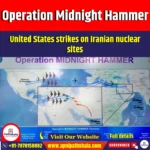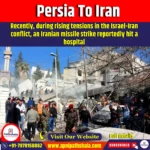Operation Midnight Hammer
General Studies Paper III: Defence Technology, Cyber Security, Challenges to Internal Security Through Communication Networks |
Why in News?
Recently, the United States carried out Operation Midnight Hammer, targeting Iran’s covert nuclear sites. The operation employed precision tactics and advanced weaponry. It aims to slow Iran’s nuclear program and to make regional peace.
What Was Operation Midnight Hammer?
- Operation Midnight Hammer was a secret U.S. military strike executed on June 21–22, 2025, targeting three Iranian nuclear sites.
- The mission reflected deep-seated tensions in U.S.–Iran relations.
- This assault was designed to neutralize key nodes in Iran’s nuclear infrastructure.
- According to U.S. officials, the mission was carefully aimed at disrupting Iran’s nuclear weapons program while also sending a strong warning in response to earlier Israeli military actions in the region.
- The operation marked the first operational deployment of the GBU‑57 Massive Ordnance Penetrator (MOP)—a 30,000‑lb bunker-buster, designed specifically for destroying deeply buried targets.
- Its secrecy, precision, and technical sophistication mark it as a defining moment in modern military operations.
Where Did the U.S. Strike and Why?
In Operation Midnight Hammer (June 21–22, 2025), the U.S. military launched a coordinated strike on three pivotal Iranian nuclear facilities—Fordow, Natanz, and Isfahan.
- Fordow Fuel Enrichment Plant:
- Located approximately 30 km north of Qom, deeply embedded under 80 m of mountain rock, Fordow is one of Iran’s most hardened nuclear sites.
- Built in 2006, initially as a Revolutionary Guard missile base, it later shifted to uranium enrichment, producing near-weapons-grade uranium (up to 83.7% U‑235 by 2023).
- Isfahan Nuclear Technology Center:
- Located about 350 km southeast of Tehran, Isfahan hosts the Uranium Conversion Facility, fuel fabrication plants, and multiple small research reactors.
- It plays a vital role in converting yellowcake to UF₆, the feed material for enrichment, and fabricating reactor fuel.
- Natanz Nuclear Facility:
- Situated on Iran’s central plateau, Natanz is Iran’s main uranium enrichment hub, with over 50,000 centrifuges, most located in fortified underground halls.
- Established in the early 2000s, its pilot plant began enriching uranium to 20% in 2010, later reaching 60% enrichment.
- Reasons:
- Fordow and Natanz contain Iran’s most advanced enrichment infrastructure, enabling near-weapons-grade uranium output.
- Fordow’s underground depth protected it until elite bunker buster bombs were deployed—an option unavailable to other countries.
- Natanz’s and Isfahan’s location and setup allowed for targeted strikes with reduced risk of broader collateral damage.
Weapons & Technology Used in This Operation
- GBU‑57 Massive Ordnance Penetrator:
- The centerpiece was the 30,000-pound GBU‑57 “MOP”, the heaviest non-nuclear bunker-busting bomb in the U.S. arsenal.
- Equipped with a high-density steel casing and smart fuzing, it’s designed to bore through up to 60 m of earth or 18 m of reinforced concrete, then explode inside fortified bunkers.
- Each bomb measured over 20 ft in length, and only the stealthy B‑2 Spirit bomber can carry up to two of these massive ordnance penetrators.
- During the mission, 14 MOPs were released on Iran’s Fordow and Natanz sites, marking the first-ever operational use of this weapon.
- B‑2 Spirit Stealth Bombers:
- The B‑2 Spirit stealth bomber played a critical role in the operation.
- The B‑2 Spirit uses advanced stealth design that reduces radar visibility. Its shape and special materials help it bypass enemy air defenses effectively.
- It can fly over 11,000 kilometers without refueling. With aerial refueling, it can cover global targets from U.S. bases.
- The bomber can carry up to 40,000 pounds of weapons. This includes nuclear and conventional bombs.
- Tomahawk Cruise Missiles:
- They can travel more than 1,600 kilometers, making them ideal for deep strikes without entering enemy territory.
- These missiles fly at subsonic speeds (about 880 km/h) and use terrain-hugging navigation.
- Tomahawks use GPS, TERCOM, and DSMAC for targeting.
- They can be launched from ships, submarines, and even modified land systems.
- Support Aircrafts:
- The mission was supported by a battalion of 125+ U.S. aircraft, including fighter escorts, refueling tankers (KC‑46 Pegasus and KC‑135), and electronic warfare jets.
Objectives of Operation ‘Midnight Hammer’
- Preventing Nuclear Weapon Breakout: The primary goal was to degrade Iran’s ability to weaponize nuclear technology. By targeting crucial enrichment installations at Fordow and Natanz, U.S. officials sought to extend Iran’s “breakout time”—the window in which Iran could assemble a bomb—to a longer timeframe, reducing the immediacy of the threat
- Supporting Global Non-Proliferation Regimes: The U.S. action aligns with the Nuclear Non-Proliferation Treaty (NPT), to which Iran is a signatory. While Iran’s compliance has been controversial, damaging its nuclear infrastructure through strikes sends a message supporting the NPT’s objectives.
- Demonstrating Military Resolve: By deploying state-of-the-art weaponry like the GBU-57 bunker-busters, the U.S. demonstrated its capability to penetrate fortified sites. The readiness to use these capabilities conveys a strong deterrence signal, not just to Iran, but to any state considering shortcutting nuclear protocols.
How the Operation Was Executed?
- The mission began late on June 21, 2025, as a large U.S. strike package took off from Whiteman Air Force Base in Missouri, including seven stealth B‑2 bombers with minimal public notice.
- Over 30 aerial refueling tankers were staged in advance across Europe—in bases like Germany, Spain, and the Azores—to support the 18-hour nonstop flight.
- A key tactic was sending a decoy package: several B‑2 bombers were flown toward the Pacific and Guam, deliberately producing radar signatures to mislead Iranian surveillance.
- While the decoys drew attention westward, the real seven B‑2s flew east across the Atlantic and Mediterranean on a quiet route to the Middle East.
- As the bombers neared Iranian airspace, they maintained radio silence, relying on minimal communications to avoid interference or detection.
- Over Iran, 4th- and 5th-generation fighter jets—escorting at high altitude and speed—cleared the skies and led suppression operations to cripple surface-to-air missile systems.
- At approximately 6:40 PM ET (2:10 AM Iran time), the lead B‑2 dropped two GBU‑57 Massive Ordnance Penetrators (MOPs) on Fordow, followed by a total of 14 MOPs across Fordow and Natanz.
- Meanwhile, over 125 aircraft—including bombers, escorts, tankers, and espionage platforms—coordinated in a tightly timed maneuver to uphold stealth.
- A U.S. Navy submarine operating under CENTCOM launched nearly 30 Tomahawk missiles toward Isfahan just moments before the final bomber reached its target.
- After dropping their weapons, the strike aircraft left Iranian airspace safely, facing no interception from enemy air defenses — a clear sign that the stealth and escort strategy had worked well.
- The bombers refueled in-flight on their return and landed back in Missouri after a flight exceeding 37 hours—the longest-ever B‑2 operational mission.
Aftermath of Operation Midnight Hammer
- Fordow suffered three deep craters near ventilation shafts. While GBU‑57 bunker-busters struck, specialists caution they likely used shockwaves to collapse critical sections.
- Natanz saw surface-level destruction of buildings and a major crater. Satellite imagery suggests inside damage.
- Isfahan, struck by Tomahawk cruise missiles, experienced losses in conversion and fuel fabrication facilities.
- IAEA Director Rafael Grossi confirmed heavy damage across all sites without off-site radiation or absolute confirmation of enrichment chamber collapse.
- Iran condemned the strikes as unjust aggression and warned of “everlasting consequences”.
- The U.N. Security Council convened an urgent meeting, reflecting international concern over destabilization.
Global Impact of Operation Midnight Hammer
- Geopolitical Shifts: The strike intensified U.S.–Iran tensions and has driven Iran closer to Russia and China. Experts fear this could shift global alignment toward an “Axis of Resistance” or even include states like North Korea.
- Energy Market Disruption: Following the attack, global oil prices spiked by 10–14%, with concerns mounting over a potential shut-down of the Strait of Hormuz—a key global shipping chokepoint handling nearly 20% of the world’s crude. This disruption raised inflationary pressures and economic volatility.
Regional Tensions: Iran responded by launching ballistic missiles toward Israel and hinted at using regional proxies like the Houthis. The possibility of Iran targeting U.S. bases. Military installations from Bahrain to Qatar remain on high alert.









